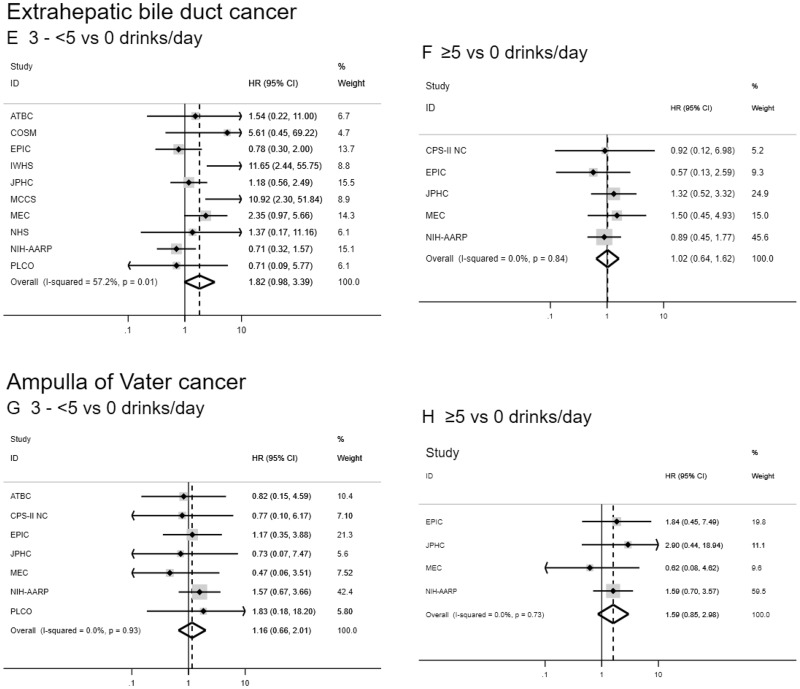Figure 2.
Forest plots for associations between alcohol consumption (drinks per day) and biliary tract cancer risk by anatomic site in the Biliary Tract Cancers Pooling Project. Hazard ratios for three to fewer than five vs zero drinks per day (A, C, E, G) and five or more vs zero drinks per day (B, D, F, H) are adjusted for sex (male, female), race (white, black, Asian and Pacific Islander, other), education (less than high school graduate, high school graduate, some college or post-high school training), body mass index in kg per m2 (<18.5, 18.5–<25, 25–<30, ≥30), diabetes (ever vs never diagnosed), birth cohort (1870–1899, 1900–1909, 1910–1919, 1920–1929, 1930–1939, 1940–1949, 1950–1959, 1960–1982), and cigarette smoking status (never, former, current). Small black-filled diamonds represent the point estimates for each study. Horizontal lines represent 95% confidence intervals; if ending in an arrow, the interval transcends the region plotted. % weight describes the weight (inverse variance) each study contributed to the summary hazard ratio. Study weight is also represented by the shaded gray region around each study-specific point estimate. I2 is the percentage of variation due to between-study heterogeneity. Summary hazard ratios (dotted lines) and 95% confidence intervals (hollow diamonds) were estimated via random-effects meta-analysis. All statistical tests were two-sided. P values were calculated using the Wald test. Some additional studies collected information on alcoholic drinks per day but could not contribute to this meta-analysis because they did not have a sufficient number of biliary tract cancer patients consuming three to fewer than five or five or more drinks per day. ATBC = Alpha-Tocopherol, Beta-Carotene Cancer Prevention Study; CI = confidence interval; COSM = Cohort of Swedish Men; CPS-II NC = Cancer Prevention Study II Nutrition Cohort; EPIC = European Prospective Investigation into Cancer and Nutrition; HR = hazard ratio; IWHS = Iowa Women’s Health Study; JPHC = Japan Public Health Center-based prospective Study 1 and 2; MCCS = Melbourne Collaborative Cohort Study; MEC = Multiethnic Cohort Study; NHS = Nurses’ Health Study; NIH-AARP = National Institutes of Health-American Association of Retired Persons Diet and Health Study; PLCO = Prostate, Lung, Colorectal and Ovarian Cancer Screening Trial; VITAL = VITamins and Lifestyle Study; WHI = Women’s Health Initiative.


